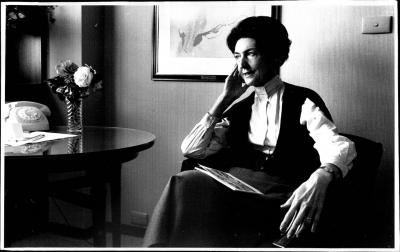Review: The Collected Stories of Shirley Hazzard

ROME - It is convenient to have all Shirley Hazzard's stories together, particularly as it is in a handsome edition. It consists of her two collections of short stories, 10 uncollected or reprinted stories, plus two previously unpublished anywhere.
Her first collection, 'Cliffs of Fall', has distinctive Hazzard women found also in her novels, women totally possessed by love although it is not emphatically erotic, and enchanted by their male partners despite the fact that the males often treat them with brutal frankness.
The women suffer but survive the male harshness. In one of the stories, an unimaginative character says 'Romantic passion is a disease' but further stories suggest he had hit the target.
The protagonists tend to be well-off, unusually articulate women who may be living in or outside the United States but refer to New York as an operative centre, perhaps because Hazzard wanted the stories in The New Yorker magazine.
Another type of story is that of the foreigner, often English, discovering Siena and its surrounding countryside. It may be an English woman shocking a staid Sienese man, a group of travellers comparing their reactions or an Englishman, Mr. Fenwick, recording his reaction to the Tuscan sky –‘in England , where heaven is a low-hung, personal affair, thoroughly identified with the King James Version, a sky such as this would not have been tolerated for a moment. It was a high, pagan explosion, promising indulgence for all kinds of offences to which he had not the slightest inclination. He felt, beneath it, exposed and ridiculed.’
After leaving school in Sydney at 16, Shirley had gone with her diplomat father to Hiroshima arriving shortly after its destruction, then worked for British Intelligence in Hong Kong. For health reasons the family moved to New Zealand
The next stop was New York where, while her parents battled through an acrimonious divorce, for years Shirley clerked at the United Nations headquarters and hated every minute of it. She jumped at a chance to transfer to a United Nations post in Italy which inspired her to write. She posted a story to 'The New Yorker. They wanted it, they wanted more.
As she modestly put it, 'God did something for Shirley.'
Her 10 new stories, collected as ' People in Glass Houses' differed from their predecessors as they were all about the United Nations either at headquarters or at one of its foreign missions. Some characters recur from story to story, it could be called a discontinuous novel.
While some ‘Cliffs of Fall’ characters had been criticized as incredibly articulate WASPS with a tendency to quote faded 19th century poetry, those in ‘People in Glass Houses’ are recognisable contemporaries of many colours and varieties. Moreover each has their place in the all-embracing organisation which keeps double files on all its employees. Hazzard has fun exposing the employees’ hypocricies but she also creates some who retain their original United Nations idealism but, when faced with choice between the ideal and bureaucratic requirements, know which side their bread is buttered.
Miss Sadie Grange, secretary to the boss of the Department of Aid to the less Technically Oriented, epitomises the Organisation. The boss, who on his first day decides she is a ‘battleaxe’ he must get rid of swiftly, retains her because she is efficient and knows the Organisation. His dependence on her reflects his convenient compromise- he wants many voices heard but will never really rock the Organisation.
It is a reminder that Shirley Hazzard rocked the United Nations from the outside, with her book and press campaign against the previous pro-Nazi activities of its Secretary-General, Kurt Waldheim. Sometimes classified as an aesthete, she had profound political convictions.
One of the previously uncollected stories concerns a 4 year old child in Sydney in 1935 when Shirley was four. Her mother is called Katy, as was Shirley’s mother who, although loving, had a quick temper. It is set in a comfortable dwelling on Woollhara road, Sydney, which is suffering a drought as well as the Depression. A female hobo arrives requesting help. The girl of Shirley’s age, who has taken her shoes off, plays with her doll on the floor while overhearing a conversation between her mother and the hobo.
The mother leaves the room and later the little girl follows her. But when she returns, the hobo has left with her doll and the shoes. She is angry and expects her mother to make a huge scene but, enigmatically, she does not say a word.
The Collected Stories of Shirley Hazzard
do-ol



